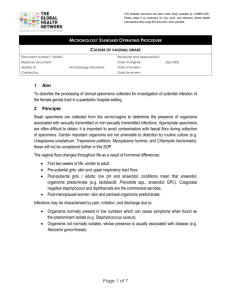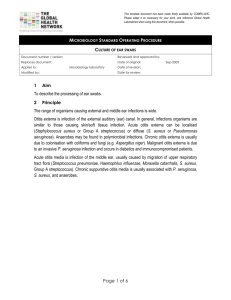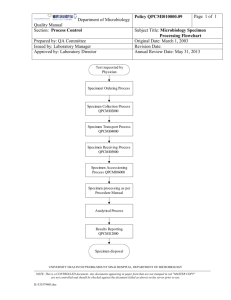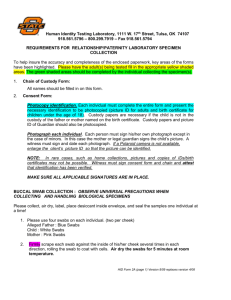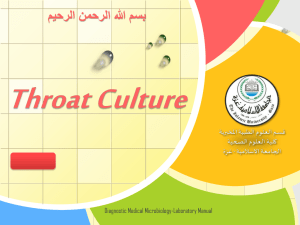1 - Global Health Laboratories
advertisement
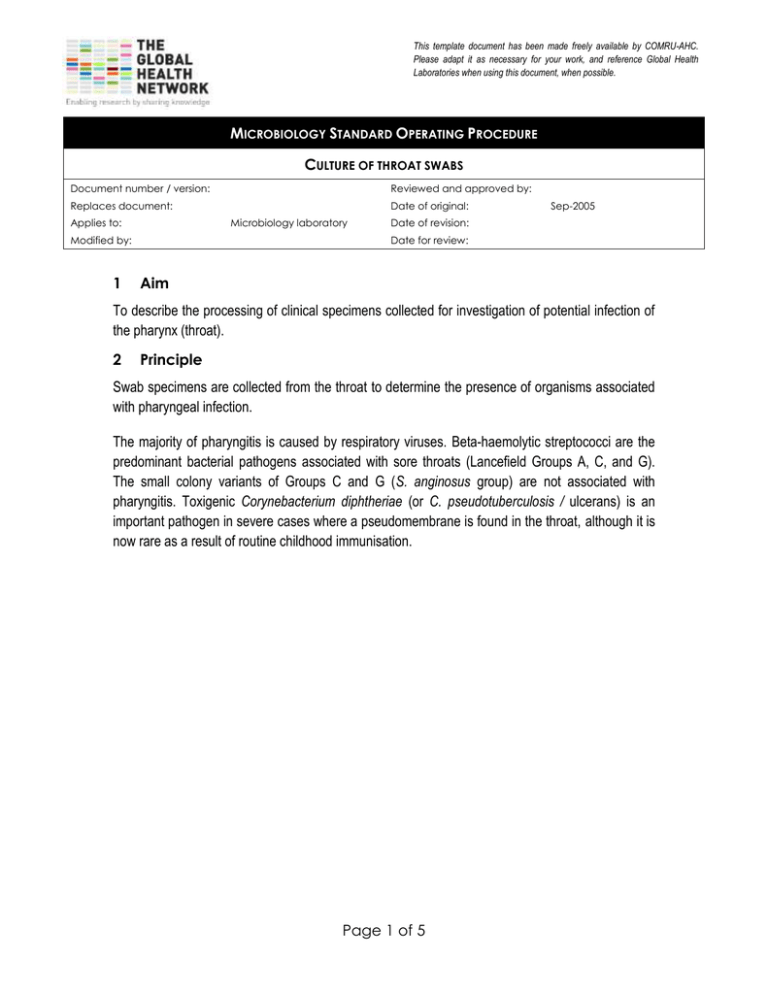
This template document has been made freely available by COMRU-AHC. Please adapt it as necessary for your work, and reference Global Health Laboratories when using this document, when possible. MICROBIOLOGY STANDARD OPERATING PROCEDURE CULTURE OF THROAT SWABS Document number / version: Reviewed and approved by: Replaces document: Date of original: Applies to: Microbiology laboratory Modified by: 1 Sep-2005 Date of revision: Date for review: Aim To describe the processing of clinical specimens collected for investigation of potential infection of the pharynx (throat). 2 Principle Swab specimens are collected from the throat to determine the presence of organisms associated with pharyngeal infection. The majority of pharyngitis is caused by respiratory viruses. Beta-haemolytic streptococci are the predominant bacterial pathogens associated with sore throats (Lancefield Groups A, C, and G). The small colony variants of Groups C and G (S. anginosus group) are not associated with pharyngitis. Toxigenic Corynebacterium diphtheriae (or C. pseudotuberculosis / ulcerans) is an important pathogen in severe cases where a pseudomembrane is found in the throat, although it is now rare as a result of routine childhood immunisation. Page 1 of 5 This template document has been made freely available by COMRU-AHC. Please adapt it as necessary for your work, and reference Global Health Laboratories when using this document, when possible. MICROBIOLOGY STANDARD OPERATING PROCEDURE CULTURE OF THROAT SWABS Document number / version: 3 Method 3.1 Specimen collection Specimens should be collected using sterile swabs and placed into Amies transport medium (+/charcoal). 3.2 Specimen transport and storage Specimens should ideally be stored and transported in sealed plastic bags. Laboratory processing should occur as soon as possible after specimen collection. Specimens should be refrigerated if delays in processing over two hours are unavoidable. 3.3 Specimen processing 3.3.1 Reception Log the specimen in the appropriate specimen book and assign a specimen number. 3.3.2 Microscopic examination Gram staining is not required. 3.3.3 Culture Inoculate a sheep blood agar plate (BA) and incubate at 35 - 37C for 20 - 24h in 5 – 10% CO2. If the request form states that the patient is HIV positive or “?candida / yeast infection” then also inoculate a Sabouraud agar plate (SAB): culture at 35 - 37C for 40 - 48h in air (read plates daily). If the clinician suspects gonorrhoea / sexual abuse then also inoculate a GC plate: culture at 35 37C for 40 - 48h in 5 – 10% CO2 (read plates daily). If the clinician requests melioid culture, refer to SOP MIC-013. 4 Interpretation Record the semi-quantitative growth of beta-haemolytic colonies (i.e. +/- to ++++). 4.1 Minimum level of identification in the laboratory Beta-haemolytic streptococci should be confirmed by Gram stain, catalase, and Lancefield group (summarised in SOP MID-004). Page 2 of 5 This template document has been made freely available by COMRU-AHC. Please adapt it as necessary for your work, and reference Global Health Laboratories when using this document, when possible. MICROBIOLOGY STANDARD OPERATING PROCEDURE CULTURE OF THROAT SWABS Document number / version: Significant isolates: Group A, C, and G beta-haemolytic streptococci Corynebacterium diphtheriae (or C. pseudotuberculosis / ulcerans) Burkholderia pseudomallei Yeasts (report as “yeasts”) – if Sabouraud plate inoculated Neisseria gonorrhoeae 4.2 Antimicrobial susceptibility testing All significant isolates should have antimicrobial susceptibilities determined according to SOP MIC001. 4.3 Reporting Culture results: presence of significant isolates (i.e. Group A, C or G beta-haemolytic streptococci); no significant growth; absence of growth. 5 Quality assurance Media and identification tests should be quality controlled according to the relevant SOP. 6 Limitations Prior antimicrobial use may result in negative cultures. 7 References 1. Health Protection Agency, UK SOP B24: Investigation of Throat swabs (Issue 8.2; December 2012). Page 3 of 5 This template document has been made freely available by COMRU-AHC. Please adapt it as necessary for your work, and reference Global Health Laboratories when using this document, when possible. MICROBIOLOGY STANDARD OPERATING PROCEDURE CULTURE OF THROAT SWABS Document number / version: 8 Synopsis / Bench aid Page 4 of 5 This template document has been made freely available by COMRU-AHC. Please adapt it as necessary for your work, and reference Global Health Laboratories when using this document, when possible. MICROBIOLOGY STANDARD OPERATING PROCEDURE CULTURE OF THROAT SWABS Document number / version: 9 Risk assessment COSHH risk assessment - University of Oxford COSHH Assessment Form Description of procedure Culture of throat swabs Substances used Variable, depending on organism cultured (may include Gram stain reagents; 3% hydrogen peroxide (catalase test); Phadebact GC test; streptococcal grouping kit (Oxoid)) Quantities of chemicals used Frequency of SOP use Small Daily Hazards identified Could a less hazardous substance be 1. Autoclaved liquid used instead? 2. Potentially infectious material in sample No 3. Potentially pathogenic bacteria 4. Chemical exposure form bacterial identification tests What measures have you taken to control risk? 1. Training in good laboratory practices (GLP) 2. Appropriate PPE (lab coat, gloves, eye protection) 3. Use of biosafety cabinet for reading of plates / follow-up of BSL-3 organisms (e.g. B. pseudomallei) Checks on control measures Observation and supervision by senior staff Is health surveillance required? Training requirements: No GLP Emergency procedures: Waste disposal procedures: 1. Report all incidents to Safety Adviser 1. Sharps discarded into appropriate rigid 2. Use eyewash for splashes containers for incineration 3. Clean up spills using 1% Virkon or 2. Infectious waste discarded into autoclave bags chemical spill kit or 1% Virkon solution prior to autoclaving and subsequent incineration 3. Chemical waste disposed of according to manufacturer’s instructions Page 5 of 5



